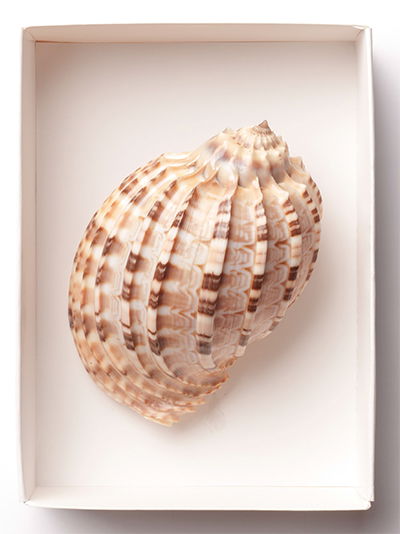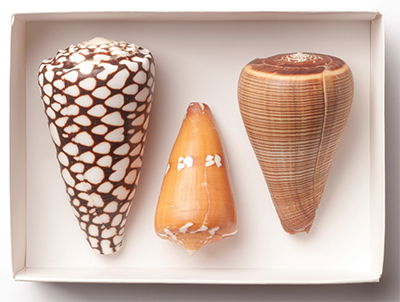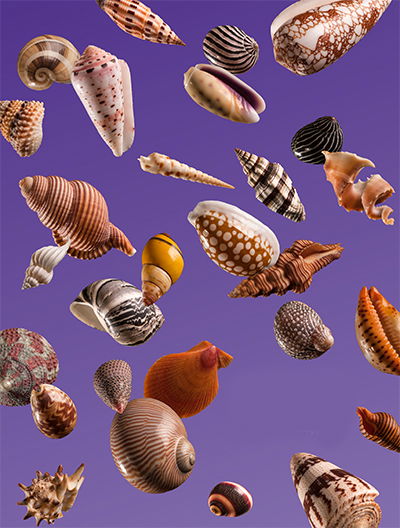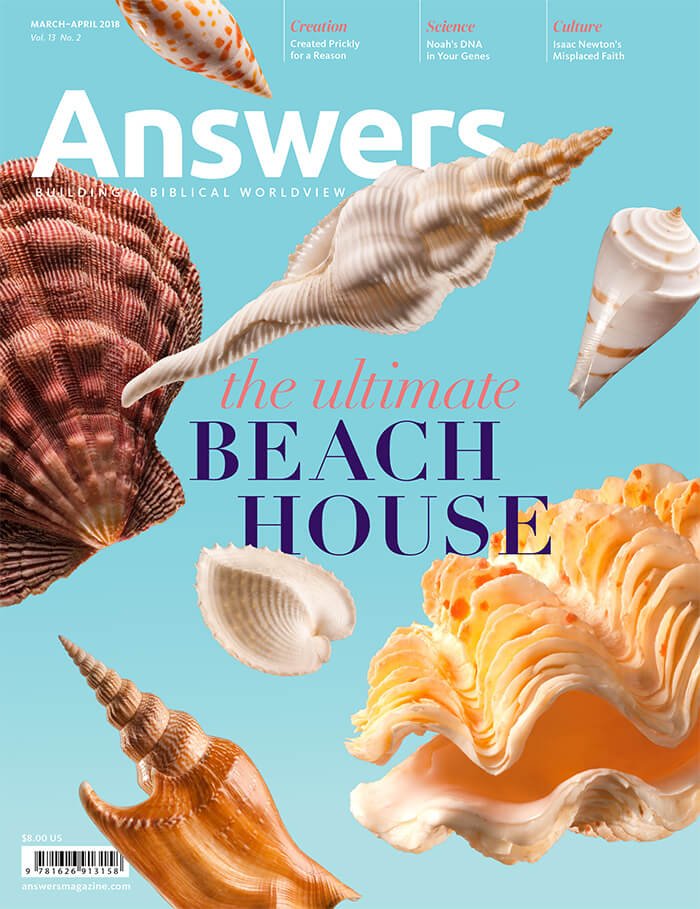
Shells—The Ultimate Beach House
The beach beckons us with its seashells. More than just ornate collectables, they testify to the Creator’s lavish provision for even the lowliest creatures.
Growing up in Southern California affords endless opportunities for adventure. A short drive away from the city are towering mountains, where you can spend a weekend playing in the snow. Just a few miles in another direction, sandy hiking trails crawl through some of the hottest deserts on the planet. If you don’t like roughing it, you never have to leave the confines of Los Angeles to enjoy an endless smorgasbord of shows, concerts, and food trucks.
Me? I always loved the beach. On a hot summer day, there’s nothing like a cool, crisp ocean breeze to wash away all your troubles. As you walk along the shoreline, your toes sink into the warm, wet sand. Gentle waves lap against the shore, while the scent of salt water makes you glad just to be alive. Looking out over the ocean, your mind naturally drifts to thoughts about the greater power beyond.
But I’m a little different. I love shells most of all, and not for the reason most people do. When I’m standing at the beach and glimpse a shell, my mind races to an alien world just beneath the ocean surface. As a biologist, I know that few places on earth are as difficult as the intertidal zone. Every day the animals that live here must face extreme heat and dryness from the beating sun, followed by rising tide waters that completely inundate them. Meanwhile, a frightening menagerie of predators from both worlds—seagulls, otters, jellyfish, and starfish—lurk nearby.
Each shell is a testament to the Creator’s provision for life at the edge of land and sea.
When I pick up a shell, it tells me a magnificent story of life, struggle, and ultimately death. Like someone who seeks out abandoned cabins because he loves the Old West, I see more than empty rooms and dilapidated walls. Each shell is a testament to the Creator’s provision for varied and abundant animals that are masters of life at the edge of land and sea. Once you understand how the Creator built these creatures to handle these extremes, I don’t believe you’ll ever see a shell the same.
Like an RV but So Much Better
I still remember the first shell I ever found. Its outer color is not what attracted me. It was drab and gray with concentric rings. On the inside, however, its natural iridescence caught my eye and indicated elegant design. Why did a creature put so much effort into constructing such beautiful walls, like the inside of a vase, that no one will ever see?
It’s a home. And not just any home. As the creature grows, it must constantly rebuild its home from the inside to make room. Have you heard the old adage of constructing a plane while it’s in the air? Well, that’s what these shelled creatures do their whole life long! They don’t have the luxury of building their dream home first and then moving in. Instead, they haul their RV around as they go, incessantly remodeling, expanding, and repairing their home.
Each style of home is built according to the inhabitant’s unique specifications. My first shell belonged to an organism common in the intertidal ecosystem, the California mussel. You must use your imagination to see how this bowl-like shell was once a “home.” Most of the time, you find only half of the shell because the crashing sea usually separates the two halves. I was lucky enough to find the entire shell of this bivalve, and my interest in shells grew into something of an obsession.
The mussel’s home consists of two rounded walls, held together by powerful muscles. It looks for a nice neighborhood then settles in and opens its walls to let food filter in. When the tide goes out or a suspicious intruder approaches, it temporarily closes shop. . . . But I’m getting ahead of myself. Let’s first pause to consider the unique designs common to all seashell walls, the key to surviving the challenges of intertidal life.
Three Distinct Wall Layers
Other creatures, such as lobsters and crabs, technically make shells consisting of a material called chitin. But most shells that we collect at the beach are made by a group of creatures called mollusks, which includes snails, clams, and mussels. Their shells are made of calcium carbonate, which is very durable and can have a smooth sheen like fine porcelain. Of all the shell-making animals, mollusks have the most interesting and beautiful shells.

Photo by Chris Neville
The California mussel builds in one direction as it grows. Each “home improvement” appears as a new band on its shell.
Mollusks begin making these shells while they are microscopic larvae floating with the current. Eventually they settle on the ground and look for a permanent home, moving on their single “foot” that drags them through the sand and mud. All the while, they keep building a larger and larger shell to give them a safe place to live as they grow.
Earlier I compared their homes to RVs, but they’re more like mobile fortresses or bomb shelters. How a soft creature with no backbone builds such massive walls is a wonder all by itself. Every mollusk is covered by a tissue layer, called the mantle, that secretes the material that hardens into its shell.
Although the shells vary from species to species, certain features are present in almost every mollusk. The shell usually has three distinct layers, with three unique tasks. The thin outer layer, called the periostracum, protects the inner layers from dissolving in the salt water. It is made of a flexible material somewhat like your fingernails. The material easily flakes off and helps the structure endure the incessant waves. Erosion explains why mussels’ outer shells aren’t very pretty, but they get the job done.
The thick middle layer is made of calcium carbonate and forms the thick, hard, permanent wall of the shell. Carbonate is formed by combining water and carbon dioxide (CO2), which is common in the ocean. Indeed, the oceans are called “CO2 sinks.”
Finally, the inner nacreous layer, commonly known as mother of pearl, is what catches our eyes on the inside. It’s the same material oysters use to make pearls. The ingenious combination of organic and inorganic material, sort of like bricks, makes it incredibly strong. Even today, scientists don’t fully understand the complex process involved in combining these materials. By design, mollusks constantly coat their inner shell with this material, trapping debris and parasites in the coating so they maintain a safe, clean living environment, even while drawing in gallons of dirty seawater every day.
As you might have guessed, mollusks don’t grow their shells willy-nilly. Once a wall is built, it’s not going anywhere! So they carefully build in one direction to make it easier to grow from their existing space into the new, larger space. It’s equivalent to building onto your house without ever going outside. Most of the growth takes place near the opening of the shell, leaving concentric growth lines and a specific pattern. The oldest part of the shell, called the umbo, is at the very top, farthest away from the opening. Food enters through the newer opening and passes through the older exit in the back. If you explore the material within the shell closely, you can trace the path the animal took as it meandered through life.
Mussels are called filter feeders because they filter out debris (wastes from other organisms or the remains from dead organisms). This makes them a very important part of the food webs of the oceans. Some call them the kidneys of the ocean.
Since these layers appear slowly and don’t go away, every animal’s shell provides clues about where the animal has been and what it has been doing. By the time we find the shell washed up on a beach somewhere, it is a masterpiece that provides a history of the individual’s life. Each shell is unique to the animal inside and tells its own story.
Design Portfolio

Photos by Chris Neville
The incredible variety of shell shapes reflects the limitless number of ways they meet the challenges of life undersea. At the same time, they showcase their Designer’s infinite imagination.
So Many Ways to Build a Home
The varied ways that these wonderful creatures overcome the challenges of their environments are incredible. The differences are so vast that biologists have divided mollusks into eight completely different scientific classes based on their methods of home-building. To grasp the significance of classes, consider that all mammals belong to the same class, but mollusks belong to eight different classes!
We’re just not trained to recognize the significant differences required to build such varied structures. A skyscraper and a log cabin are both “buildings” and have many similar parts, but they require very different blueprints. God designed blueprints for all the mollusks. Explaining the full variety would literally fill a bookshelf, so let me share a handful of my favorites to make the point that every shell is special.
Premier Sand Diggers
Olive snails are a favorite among collectors, famed for their subtle yet beautiful shades of color and designs. They are found in tropical and subtropical waters all over the world, buried in the sandy intertidal areas on most continents. The namesake genus, Oliva, commonly washes onshore in California, where Native Americans once collected them to make necklaces and other jewelry. They provide collectors an opportunity to see something called overdesign, an animal feature that doesn’t help it survive. Instead, the intricate patterns look like these animals were meant to decorate the ocean floor.
Unlike mussels, which are attached to the sides of rocks and filter food from the water, olives are designed to dig in the sand. In fact, they’re champs, with an ideal shape for quick movement (if you’re dragged around by a single foot). With a body shaped a bit like a torpedo, these snails disappear into the sediment in mere seconds. While the mussel has a broad shell to catch food and a notch in the middle where it’s collected, olives have a notch at one end of a long cylinder that spirals out in a stepped spire.
The Armor Bearers
Another popular family of shells is Angariidae, which contains a single genus, Angaria. These shells win the prize for incredible architecture. Their showy defensive features are somewhat reminiscent of dinosaurs. Angaria sphaerula, for instance, has long spines all over the shell. Each spine develops in a precise, programmed sequence. Like the spikes on the back of the tanklike Ankylosaurus dinosaur, every spine adds another punch to any object that might try to crush these elegant animals.
Natural “Harps”

Photo by Chris Neville
The ribs on the harp snail combine beauty and strength in a way that inspires awe for its Designer.
The harp snails often have long “ribs” that run along the length of the entire shell. While collectors appreciate and enjoy the variety of complex ribs and their colors, evolutionary scientists note that the ribs add protection from predators. It’s interesting how little they say about the things we notice most. The reason is that they believe “survival” is the key to explain all designs. Wouldn’t it make more sense to believe these beautiful animals were designed from the beginning to inspire awe for their Designer?
My personal favorite of the harp snails is Harpa amouretta, which contains alternating bands of cream and brown, with purple and black accents. Snail experts can’t explain the color patterns. So each time I look at them, they remind me that God must have taken great pleasure to add such beautiful features to these snails solely for our enjoyment and his glory.
Conch shells
Conch shells are some of the largest and most beautiful of all the shells in the ocean. People have collected and used them as tools and musical instruments for hundreds of years. These animals are enormous by snail standards and build houses that rival anything a human can make. The most interesting thing about these shells is the pink color that you find on the inside. This color is the most vibrant pink you can find anywhere, and it remains hidden on the inside of these shells for only the snails, their Designer, and collectors like me to enjoy. These are the classy Airstreams of the snail RV world. They are long and sleek on the outside and contain a hidden beauty on the inside.
A Healthy Reminder of a Dangerous World

Photo by Chris Neville
Bright colors often signal danger. Cone snails alert predators to stay away—they’re hiding a deadly weapon inside.
My favorite of all shells reminds me of the danger of the oceans, while best illustrating overdesign in mollusks. Cone snails seldom show up on beaches, yet people from all over the world earnestly collect them because of their exceptionally vibrant colors. As is true among land animals, bright colors on ocean snails usually signal danger. They hide a dangerous weapon inside their shells that looks like a harpoon. They also make a toxin, capable of subduing just about anything that comes within reach, including unsuspecting scuba divers.
We see the overdesign clearly in the venom, which is far more potent than the animal needs to subdue its prey. This shell encourages people to develop a respect for and healthy fear of God, who judged the whole world because of Adam’s sin. Along with snakes and spiders, many snails are carnivorous. God’s original “very good” creation (Genesis 1:31) is no more. While animals originally subsisted on vegetation (Genesis 1:29–30), many now eat each other. These designs remind us that the earth is cursed, and we need God’s grace to set things right as Jesus Christ will do one day.
Artist’s Palette

Photo by Chris Neville
What kind of artist could ever create such a splendid exhibition of intricate designs and colorful patterns? Only the grand Creator, who loves beauty and intended them for our enjoyment.
Design or Apparent Design
Today, shells provide mollusks with protection from the terrors of life, allowing the animals to withdraw into shelter and wait out the danger. Many scientists argue that this need for protection is enough to explain the origin, intricacy, and variety of all shells that we find on the planet. They say the complex forms don’t require a Designer, and therefore the “design” isn’t real.
The attempt to explain how so many shells could arise by chance, simply to survive, is merely guesswork, and it doesn’t begin to explain the genetic code and advanced cells and tissues in the mantle that direct this process. (And even explaining those wonders wouldn’t explain the beauty of shells.)
The shell construction continues throughout the life of the mollusk, and every step in the process must be highly controlled by an elaborate cocktail of hormones. Specific materials are programmed to be placed in specific places, at specific times, with specific designs. While each special environment influences the process, requiring ingenious flexibility in the programming to make the most of the available materials and needs, the development of the shell is highly controlled.
If the genetic codes and flexible building processes were already in place from the very beginning, it is easy to see how they were designed to continue to maintain the intricate designs in the face of predators and other dangers. It makes sense to credit God with giving mollusks designs at creation to fill the seas with beautiful life forms.
It is not possible for chance and evolutionary events to explain shells’ intricate features or variety.
But it is not possible for chance evolutionary events to bring about the first fully functional shells or to explain the origin of their intricate features or their variety. This isn’t just an everyday engineering challenge. As I’ve already explained, mollusks are designed to build, repair, and expand their homes “on the fly,” in changing circumstances! It’s an engineering nightmare that would challenge the greatest geniuses in Silicon Valley.
So shells clearly point to a grand Designer. No other explanation holds water. When you add the colorful shapes and patterns of the shells, which give the mollusks no obvious survival benefits, the shells demonstrate nothing less than the creative work of a God who loves beauty and intended them—from the beginning—for our enjoyment and his glory.
Next time you’re at the beach and see a shell, any shell, let your mind wander beyond the shell. Consider how much careful design went into making this wonderful home for even the tiniest, most insignificant animal. If God cared so much for an animal’s temporary home on earth, how much does he care for you, as he prepares an eternal place of unimaginable beauty for all his children (John 14:2)?
The shells in this article are from the vast Creation Museum collection.
Creation Museum Shell Collection Slideshow
Answers Magazine
March–April 2018
The beach beckons us with its seashells. More than just ornate collectables, they testify to the Creator’s lavish provision for even the lowliest creatures. The Creator designed shells with mind-boggling features evolution can’t begin to explain.
Browse Issue SubscribeRecommended Resources

Answers in Genesis is an apologetics ministry, dedicated to helping Christians defend their faith and proclaim the good news of Jesus Christ.
- Customer Service 800.778.3390
- © 2024 Answers in Genesis




